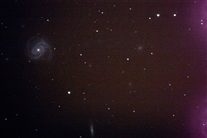m100_1600iso_300sec_f065_15.jpg
m100_1600iso_300sec_f065_15.jpg
(m100_1600iso_300sec_f065_15.jpg)
M100 -
304mm f/10.0 lx200gps 12" scope at f/6.5 with taurus tracker III focal reducer, canon 300d camera at 1600iso. Single 5min exposure. Taken at Hildebrandt Ranch.
Messier 100
Spiral Galaxy M100 (NGC 4321), type Sc, in Coma Berenices
Right Ascension 12 : 22.9 (h:m)
Declination +15 : 49 (deg:m)
Distance 60000 (kly)
Visual Brightness 9.3 (mag)
Apparent Dimension 7x6 (arc min)
Discovered by Pierre Méchain in 1781.
Excerpt from seds.org:
Messier 100 (M100, NGC 4321) is a beautiful example of a grand-design spiral galaxy, and one of the brightest galaxies in the Virgo Cluster, or Coma-Virgo of Galaxies. Like a number of other members of this cluster, it is situated in the southern part of constellation Coma Berenices.
On March 15, 1781, Pierre Méchain discovered this object, M100, together with its apparent neighbors, M98 and M99. His friend, Charles Messier, obtained its position on April 13, 1781, and included it in his catalog, immediately before finishing the third, final published edition.
M100 is one of the brightest member galaxies of the Virgo Cluster of galaxies.
M100 is a spiral galaxy, like our Milky Way, and tilted nearly face-on as seen from earth. It is among the first spirals that have been discovered, and listed by Lord Rosse as one of 14 "spiral nebulae" discovered to 1850. The galaxy has two prominent arms of bright blue stars and several fainter arms. The blue stars in the arms are young hot and massive stars which formed recently from density perturbations caused by interactions with neighboring galaxies which are lying just outside our image. Despite its nearly perfect symmetric outline, this galaxy appears slightly asymmetric, as on the southern (lower) side of the nucleus more (or brighter) young stars have formed.
Our photograph of this magnificient grand-design spiral was obtained by David Malin of the Anglo-Australian Observatory; interested readers may obtain more detailed informations on this image. From the same original plates by the Anglo-Australian Telescope, David Malin has provided more images of M100 showing also its dwarf neighbors.
Deep photographs of M100 have revealed that this galaxy is actually much larger than shown in conventional photographs. Therefore, a significant part of the galaxy's mass may lie in the faint outer regions and escape its discovery in conventional images.
M100 has been imaged extensively by the Hubble Space Telescope, which finally led to the discovery of over 20 Cepheids as well as one nova, and a distance determination of 56+/-6 million light years for M100, the first considerably reliable distance determination of a Virgo cluster galaxy (see H0 Key Project, paper IV, 1996). The high improvement of photographic resolution by the HST may be noticed in this comparison of HST to average quality KPNO 2.1m-photos.
Diane Dutkevitch of the Northwestern University has provided a Astronomy Web Lab on distance determination of M100 from HST Cepheid observations.
In the inner disk of M100 has been investigated by Nasa's Ultraviolet Imaging Telescope on its Astro-1 Space Shuttle mission. Intense star formation activity was found to take place in a ring of starburst activity along the periphery of the galaxy's innermost spiral arms.
M100 is located in the spring constellation Coma Berenices and can be seen through a moderate-sized amateur telescope. Amateurs can see the central regions of this galaxy as faint elliptical patch of uneven texture in small telescopes, or even in good binoculars. Under good observing conditions, suggestions of the inner spiral arms can be glimpsed in telescopes starting at 4 inch aperture (refractor or unobstructed reflector). Photos reveal the grand design spiral structure, as seen in every picture from our collection of amateur images of M100.
Five supernovae have been observed in M100 so far:
1901B, a type I, mag 15.6 in March 1901;
1914A of undetermined type, mag 15.7 in Feb/Mar 1914;
1959E of type I, mag 17.5 in Aug/Sep 1959, 58"E and 21"S of the nucleus, discovered February 21, 1960 and observed through June 17, 1960; and
1979C of type II, mag 11.6 on April 15, 1979, which however faded quickly. Supernova 1979C or its remnant was later observed at various wavelengths from radio to X-rays, notably in the X-ray light with the Rosat (Immler et.al. 1998) and XMM Newton (Immler et.al. 2005) satellites.
2006X of type Ia was found on February 7, 2006, when it was at 15.3 mag and still rising. Supernova 2006X was located 12"W and 48"S of M100's nucleus, and was discovered early before reaching its maximum.
